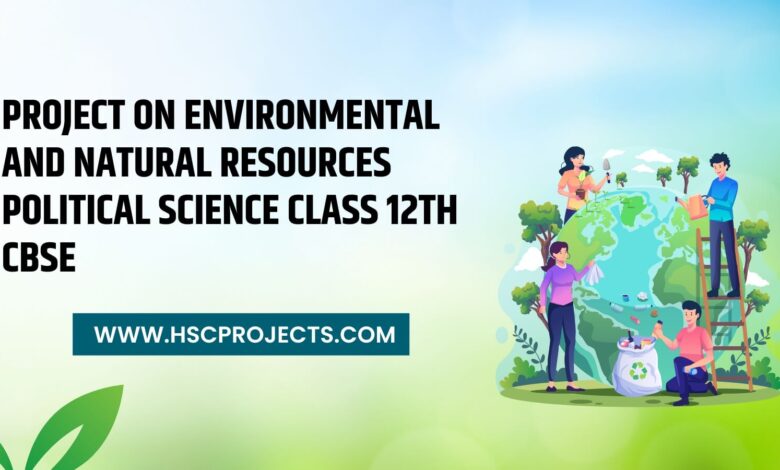
Project On Environmental & Natural Resources For Political Science – 12 CBSE
Introduction:
Environmental and natural resource issues have received growing interest from political scientists in recent years. Consequences of climate change, deforestation, and pollution are already being felt, making it all the more important to understand how political institutions and actors might address these issues. This project will investigate the intersection of environmental and natural resource policy with political science by focusing on key debates, initiatives, and actors in the area. Our goal is to learn more about how political institutions may help preserve Earth’s natural systems for future generations.

Environmental Concerns In Global Politics
Environmental problems have risen to the forefront of international politics as a result of their widespread impact on governments and populations throughout the world. Multinational bodies like the United Nations and the World Trade Organisation are just two that have prioritised environmental protection in recent years.
In international environmental politics, finding a compromise between economic growth and environmental sustainability is a hot subject. Many low-income countries argue that they should be allowed to prioritise economic growth above environmental protection so that they may help their people escape poverty. Rich countries are often blamed for not doing more to prevent climate change, despite having the resources to do so.
In 2015, 195 countries came together to sign the Paris Agreement on Climate Change, marking a turning point in the fight against climate change and other kinds of environmental degradation on a global scale. The declared objective of the agreement is to limit global warming to no more than 2 degrees Celsius over pre-industrial levels, with efforts made to limit it to no more than 1.5 degrees Celsius. certain people are concerned that the deal’s targets aren’t ambitious enough to prevent potentially disastrous climate change, and that certain countries aren’t doing enough to achieve those goals.
It is projected that environmental concerns will continue to play a significant role in international politics for the foreseeable future as governments and organisations seek to achieve a balance between economic growth, development, and environmental sustainability.
History Of Environmental Concern
Humans have always recognised that their activities have an impact on the natural world, therefore environmental protection has a long and distinguished history. Political leaders and the public did not give environmental issues much thought until the 20th century.
A turning point in the history of ecological awareness occurred when Rachel Carson’s “Silent Spring” was published in 1962. The book documented the destruction caused by pesticides, which helped to launch the modern environmental movement in the United States and abroad.
Better environmental protections and a more ecologically aware public were seen as necessary after disasters like the Exxon Valdez oil leak in 1989 and the Deepwater Horizon oil spill in 2010.
In response to these concerns, governments and international groups have implemented a range of actions to improve the environment. The United States Environmental Protection Agency (EPA) was established in 1970, and the United Nations Framework Convention on Climate Change (UNFCCC) was established in 1992, both with the goal of preserving human health and the environment.
Despite these efforts, environmental concerns continue to be a major roadblock for lawmakers and the public at large. Irrespective of recent progress, climate change remains a critical threat that demands immediate action and international cooperation.
Earth Summit 1992
The Earth Summit, or the United Nations Conference on Environment and Development, was held in Rio de Janeiro, Brazil in June 1992. We are an international community of individuals who have gathered to discuss pressing issues related to the planet’s ecology and future sustainability.
A crucial factor in the Earth Summit’s success was the fact that it was founded on the principles of sustainable development, an idea whose time had come. Agenda 21 covers a wide range of issues, such as poverty reduction, health, education, and environmental protection, with a focus on international cooperation and the engagement of all stakeholders, including governments, civil society, and the corporate sector.
During the Earth Summit, the UNFCCC (United Nations Framework Convention on Climate Change) was also approved. With the purpose of bringing down greenhouse gas concentrations in the atmosphere to acceptable levels, the United Nations Framework Convention on Climate Change (UNFCCC) has been ratified by 195 countries.
The contributions of indigenous peoples and local communities to environmental protection and sustainable development were also acknowledged during the Earth Summit. The conference emphasised the importance of indigenous and local communities’ roles as environmental stewards and called for more participation and autonomy on the part of these groups in environmental policies.
In conclusion, the Earth Summit of 1992 marked a turning point in the history of global environmental governance by fostering more international cooperation and action to address environmental concerns.
Outcomes Of The Earth Summit
Many noteworthy advances were made as a direct consequence of the 1992 Earth Summit in Rio de Janeiro, Brazil. Important compromises struck during the summit included:
Agenda 21: Global commitment to the sustainable development plan outlined in Agenda 21. Agenda 21 covers a wide range of issues, such as poverty reduction, health, education, and environmental protection, with a focus on international cooperation and the engagement of all stakeholders, including governments, civil society, and the corporate sector.
United Nations Framework Convention on Climate Change (UNFCCC): In order to prevent potentially disastrous human intervention with the climate system, 195 countries signed onto the United Nations Framework Convention on Climate Change (UNFCCC).
Adoption of the Convention on Biological Diversity (CBD): The CBD is a worldwide accord ratified by 196 countries to safeguard and sustainably exploit biological diversity.
Forest Principles: Implementation of the Forest Principles, a set of voluntary guidelines for the sustainable management of the world’s forests both now and in the future.
Rio Declaration: The Rio statement on Environment and Development, adopted at the end of the 1992 Earth Summit in Rio de Janeiro, is a non-binding statement of 27 principles for sustainable development.
The final agreements from the Earth Summit were a significant step forward in global environmental governance, paving the way for decades of international cooperation and action on environmental concerns. There are still challenges to be met, but the agreements reached at the summit have the potential to dramatically enhance environmental security and sustainable development.
The Protection Of Global Commons

Examples of global commons include the oceans, the atmosphere, and the polar regions. Our ability to conserve these resources is crucial to the survival of the planet and all of its inhabitants.
One of the main challenges to protecting global commons is the lack of clarity over who is responsible for and owns these resources. Since these assets are not owned by any one entity, it may be difficult to establish effective governance and management mechanisms for them.
In response to this issue, international agreements for the protection of global commons have been developed. One such treaty is the United Nations Convention on the Law of the Sea (UNCLOS), which lays out rules for the protection of marine life and the definition of exclusive economic zones (EEZs).
Regulations for the use of ozone-depleting chemicals were also established in the Montreal Protocol on substances that deplete the ozone layer and the Vienna Convention for the Protection of the Ozone Layer.
Another example of an effort to protect global commons is the 2015 Paris Agreement on climate change, which has been approved by 197 countries. The Paris Agreement aims to limit global warming to 1.5 °C over pre-industrial levels, with a focus on limiting warming to far below 2 °C.
Despite these efforts, protecting global commons remains challenging. Consistent international cooperation and action are required to address long-standing challenges like as illegal fishing, pollution, and climate change, all of which threaten the sustainable management and protection of these resources.
Common But Differentiated Responsibilities
The principle of common but differentiated responsibilities (CBDR) is fundamental to international environmental management. It recognises that international cooperation is necessary to protect the environment, but that individual countries’ economic circumstances and historical contributions to environmental degradation must be taken into account.
In the beginning, many believed that the UNFCCC would solve all of humanity’s concerns related to climate change. It acknowledges that industrialised countries, by virtue of their greater economic strength and historical participation in the majority of greenhouse gas emissions, have a greater responsibility to find solutions to environmental problems.
Although developing countries may not have made significant contributions in the past, the CBDR idea recognises that they now have a responsibility to do so and that their efforts to do so should be supported.
The notion of CBDR has been debated in international climate change and environmental forums. Despite developing countries’ repeated pleas for developed countries’ financial and technical aid in addressing environmental concerns, wealthy nations are often unwilling to make major commitments without equivalent efforts from poor nations.
The CBDR idea is fundamental to international environmental governance because it reflects the necessity for collective action to address environmental problems. However, ongoing conversations and agreements are necessary for the fair and effective implementation of the idea.
The Kyoto Protocol
The Kyoto Protocol was established in 1997 as an international pact to counteract global warming by the United Nations Framework pact on Climate Change (UNFCCC). This international agreement aims to reduce emissions of greenhouse gases to mitigate the effects of global warming on the environment.
As part of the Kyoto Protocol, developed countries committed to reducing their emissions of greenhouse gases by an average of 5.2 percent below 1990 levels between 2008 and 2012. The convention spawned the emission trading market, collaborative implementation, and the clean development framework.
Through carbon trading, countries that have cut their emissions more than they needed to may sell the extra reductions to others who haven’t done as well. For the sake of argument, let’s say you’re a foreigner who’s invested in a project that’s certain to fail. Rich countries may earn clean development mechanism credits by sponsoring emission-reduction projects in developing countries.
There are others who disagree that the Kyoto Protocol should be considered a turning point in the international response to climate change. One notable criticism is that the agreement does not mandate cuts in greenhouse gas emissions from rising countries, who are currently responsible for a disproportionate percentage of world emissions.
It’s also controversial because the United States and other developed countries choose not to ratify the agreement. The United States in particular voiced worries that the agreement was unjust and would negatively affect their economy since it would not compel poorer countries to lower their emissions.
The Kyoto Protocol, despite its detractors, was instrumental in the creation of subsequent international climate change treaties including the Paris Agreement. Its methods for cutting emissions have impacted subsequent efforts to counter climate change.
Common Property Resources
Common property resources (CPRs) are those that are owned and managed collectively by a community. Resources like forests, fisheries, and water systems are crucial to human survival and the economy.
CPRs have a major impact on environmental and natural resource politics because to the difficulty of regulating their use. Since different users sometimes have conflicting objectives and interests, managing CPRs may be challenging.
Giving local people the resources they need to manage their own natural resources efficiently and sustainably is at the heart of community-based natural resource management (CBNRM), a method to CPR management. CBNRM encompasses a wide range of approaches, including community-led conservation efforts, co-management collaborations with government agencies, and the creation of community-based natural resource management groups.
However, the success of CBNRM strategies may depend on factors such as community participation and empowerment, the availability of resources and technical expertise, and the level of official recognition and support for the approach.
In conclusion, CPR management is a complex and debatable issue in environmental and natural resource politics. The appropriate management of these resources requires promoting sustainable utilisation while also protecting the interests and rights of local residents.
India’s Stand On Environmental Issues
Air and water pollution, forest loss, and global warming are just a few of India’s environmental challenges. The Indian government has taken many steps in recent years to address these issues and promote sustainable development.
One of India’s most significant initiatives to date is the National Action Plan on Climate Change, which was introduced in 2008. The plan’s objectives are to make communities more resilient to climate change, reduce emissions of greenhouse gases, and enhance the use of renewable energy sources.
India has been a vocal proponent of the concept of shared but differentiated responsibilities in international climate debates. This approach recognises the various historical and current contributions of industrialised and impoverished countries to climate change.
Air and water pollution reduction efforts have also been implemented in India. Swachh Bharat Abhiyan is a government initiative that has been ongoing throughout India since 2015. As part of its strategy to reduce air pollution, the government has mandated cleaner fuel laws and promoted the use of public transit.
India has tried to address environmental issues, however the country has been plagued by issues such a lack of resources and inefficient implementation. The rapid economic growth and population increase are putting a pressure on the country’s natural resources and environment.
When it comes to environmental issues, India generally takes the initiative, despite ongoing challenges. It will require time and innovation to discover solutions to the nation’s environmental and sustainability concerns.
India’s Efforts For Environmental Conservation
India is rich in biodiversity hotspots, as well as forest and wetland ecosystems. To protect these resources and promote environmental preservation, the government has launched a number of programmes.
The Indian government established a special court in 2010 to handle environmental claims and ensure compliance with environmental laws; this court is known as the National Green Tribunal (NGT). Air and water pollution, deforestation, and other environmental challenges in India have all had conflicts resolved thanks to the NGT since its founding.
The government of India has also launched a number of programmes to promote sustainable development and environmental preservation. For example, in 2002, the National Afforestation Programme was launched with the intention of boosting the country’s forest cover and encouraging the protection of biodiversity. The National Biodiversity Act was passed in 2002 and has helped to safeguard and responsibly use India’s rich biodiversity.
India has also taken steps to reduce its impact on global warming by increasing the use of renewable energy sources. To meet the target of 175 GW of renewable energy capacity by 2022, the government has launched a number of programmes to increase solar, wind, and hydropower. As a result, the government has taken initiatives to reduce greenhouse gas emissions from industries and transportation.
A lack of community education and engagement, as well as a failure to appropriately administer and execute environmental regulations, remain challenges to India’s environmental conservation efforts. It will need cooperation between the government, nonprofits, and the private sector to solve these problems.
India’s efforts to safeguard the environment and promote sustainable development are indicative of the country’s recognition of these issues’ criticality. While there is still much work to be done, initiatives in India provide a platform for progress towards environmental sustainability.
Environmental Movement
The “environmental movement” refers to a collection of diverse political and social groups that have played a significant role in shaping contemporary environmental politics and policy throughout the globe.
In the 1960s and 1970s, a new social movement emerged in response to growing public awareness of environmental problems such pollution and deforestation. A turning point in the development of the environmental movement in the United States is often seen as the publication of Rachel Carson’s “Silent Spring” in 1962.
Lobbying, advocacy, direct action, and even civil disobedience have all been used as strategies and approaches within the environmental movement. The success of the movement may be directly attributed to the approach of educating the people about environmental issues and soliciting their participation in environmental decision-making.
The environmental movement has also had a considerable impact on international environmental policy. The movement’s activities primarily led to the 1992 Earth Summit, which produced the Rio Declaration on Environment and Development and the Agenda 21 action plan.
There has been and continues to be significant success in the environmental movement’s efforts to preserve the environment and achieve social justice. In order to safeguard the planet’s decreasing natural capital, the movement’s efforts to boost the use of renewable energy sources and reduce emissions of greenhouse gases have been essential.
The environmental movement has challenges, such as a lack of funding and support, and opposition from businesses and governments that prioritise economic growth above environmental sustainability.
The environmental movement has had far-reaching effects on politics and policy throughout the globe in response to environmental issues. If we are ever going to find lasting solutions to the environmental crises that beset our planet, it will be through the tireless efforts of the movement.
Resource Geopolitics
As a field of research, “resource geopolitics” analyses how rivalry over limited supplies of natural resources shapes international power structures.
Population growth and economic development place enormous strain on the world’s natural resources and ecosystems, making the increased demand for natural resources such as oil, gas, minerals, and water a crucial element in resource geopolitics.
As a result, competition for the world’s natural resources has emerged as a significant source of geopolitical conflict. Mineral and rare earth element resources have been at the centre of tensions between China, the United States, and other countries, while oil and gas have been at the centre of tensions between countries in the Middle East and Asia.
Extractive measures taken by governments and companies in a race for natural resources may have unanticipated negative effects on the environment and local populations.
The challenges of resource geopolitics call for more international collaboration and coordination, as well as actions to promote sustainable resource utilisation and minimise the environmental repercussions of extractive industries. Promoting sustainable growth, reducing waste, and using renewable energy are all crucial steps towards this objective.
Overall, the study of resource geopolitics demonstrates the widespread influence that natural resources have on global politics and state agendas. As the world faces increasing environmental difficulties and demands on natural resources, a more sustainable and equitable future will involve addressing the complex and interconnected issues of resource geopolitics.
Indigenous People And Their Rights
Since they were there first, a region’s indigenous people have a unique connection to the land, its resources, and the ecosystems that support them. But indigenous people across the world face significant challenges in their efforts to save their land and resources, as well as their history, language, and way of life.
The rights of indigenous peoples have recently received more attention in international politics and environmental policy. Many of the world’s remaining biodiversity hotspots and key ecosystems are located on or near indigenous territory, and indigenous people play a significant role in the protection and sustainable management of these areas.
While fighting for their rights, indigenous people encounter a number of obstacles. These include discrimination, marginalisation, and the violation of their land rights by governments and enterprises. The exploitation of indigenous peoples’ work has led to friction and conflict between indigenous communities and governments.
People’s understanding of the importance of indigenous peoples’ participation in environmental management and conservation decision-making is growing. Efforts to elevate indigenous participation in environmental policy and management, as well as indigenous people’s knowledge and cherished traditions, fall under this umbrella.
There has been a rise in awareness of indigenous peoples’ rights since 2007, when the United Nations issued the Declaration on the Rights of Indigenous Peoples, and since then, international environmental agreements like the Convention on Biological Diversity have started to respect indigenous peoples’ rights.
Facts That Matter
Climate change is one of the most pressing environmental problems we face now, driven by human actions like burning fossil fuels, clearing forests, and practising industrial agriculture.
As many as a million species have gone extinct due to human activities including habitat loss, pollution, and excessive resource extraction.
Oil, gas, and mineral competition and war have played a significant role in the evolution of international relations.
The oceans, the atmosphere, and biodiversity hotspots are all global commons that must be managed and conserved for sustainable development and the reduction of environmental hazards.
Indigenous peoples’ rights must be safeguarded, and they must be included in environmental decision-making, for the management of natural resources and ecosystems to be sustainable and fair.
It will be vital to adopt a holistic and coordinated approach to managing environmental problems due to the interconnected nature of environmental challenges with poverty, inequality, and human rights.
There is a growing agreement on the need to transition to renewable energy sources in order to mitigate climate change and decrease our influence on the planet’s limited supply of natural resources.
Words That Matter
Sustainability: To be sustainable is to meet present requirements without compromising those of future generations.
Climate Change: Changes in global or regional climate over decades or centuries, usually brought on by human actions like burning fossil fuels and cutting down forests.
Biodiversity: Diversity in species, genes, and ecosystems is what scientists call biodiversity.
Global Commons: Examples of global commons include the oceans, the climate, and areas rich in wildlife.
Common Property Resources: Examples of community-owned and -maintained resources include forests, water systems, and grazing land.
Environmental Justice: The purpose of environmental justice is to guarantee that everyone is given equal opportunities and a say in environmental policymaking and implementation.
Indigenous Rights: Indigenous rights are those of indigenous people that have been acknowledged on a global scale, including the right to their lands, resources, culture, and self-determination.
Renewable Energy: Our definition of “renewable energy” is power derived from non-exhaustible sources such the sun, wind, water, and the earth itself.
Green Economy: The phrase “green economy” is used to describe an economic system that places an emphasis on environmental and social sustainability through embracing strategies including the use of renewable energy sources, the spread of environmentally friendly technologies, and the adoption of environmentally responsible consumer practises.
When companies take steps to lessen their negative effects on society and the environment and protect the rights of their workers, they are engaging in what is known as “corporate social responsibility,” or CSR.
Conclusion
Humanity’s continued existence and the planet’s well-being depend critically on the politics of the environment and natural resources. There is a wide variety of complex issues that need to be addressed, from climate change and biodiversity loss to protecting global commons and indigenous peoples’ rights.
The basis for international cooperation and action on environmental concerns has been set by the Kyoto Protocol and other treaties and protocols that followed the 1992 Earth Summit. A lot of work remains, particularly in addressing the social and economic dimensions of environmental issues and safeguarding the rights of all parties, including indigenous people and local communities.
India has taken several steps to safeguard the environment and foster sustainable development, including the Swachh Bharat Abhiyan and the National Action Plan on Climate Change. The government must take fast action to address the pressing issues of air and water pollution and soil degradation.
Environmental and natural resource politics need the involvement of governments, civil society, and the private sector. If we all pull together, we can create a brighter, more equitable future for generations to come.
Certificate
This is to certify that I, [Your Name], a student of Class 12th CBSE, have successfully completed the project on “Environmental and Natural Resources for Political Science” under the guidance and supervision of my esteemed teachers.
The project aimed to explore the intersection of environmental and natural resource policy with political science, focusing on key debates, initiatives, and actors in this area. Throughout the research and analysis, I delved into the consequences of climate change, deforestation, pollution, and the importance of political institutions in addressing these critical issues.
I have thoroughly examined global environmental concerns and the role of multinational bodies like the United Nations and the World Trade Organisation in prioritizing environmental protection. The landmark Paris Agreement on Climate Change, signed by 195 countries, and the Earth Summit of 1992, which laid the foundation for international cooperation on environmental governance, were highlighted in the project.
Moreover, I explored the history of environmental concern, the concept of common but differentiated responsibilities, and the impact of the Kyoto Protocol on global climate change efforts. The project also shed light on the significance of common property resources, the role of indigenous people in environmental conservation, and the rise of the environmental movement as a crucial force in shaping environmental policy worldwide.
I would like to express my gratitude to my teachers, whose guidance and encouragement were invaluable throughout the project. Their support helped me gain a deeper understanding of environmental and political complexities, and I am grateful for the knowledge and skills acquired during this endeavor.
I extend my sincere thanks to my parents and peers for their constant encouragement and understanding during the project’s execution.
[Your Name]Class 12th CBSE Student[Your School Name][Date]
In order to download the PDF, You must follow on Youtube. Once done, Click on Submit
Follow On YoutubeSubscribed? Click on Confirm
Download Project On Environmental & Natural Resources For Political Science – 12 CBSE PDF






